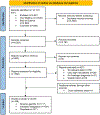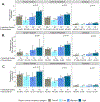Prevalence of Gastric Precursor Lesions in Countries With Differential Gastric Cancer Burden: A Systematic Review and Meta-analysis
- PMID: 38438000
- PMCID: PMC11272442
- DOI: 10.1016/j.cgh.2024.02.023
Prevalence of Gastric Precursor Lesions in Countries With Differential Gastric Cancer Burden: A Systematic Review and Meta-analysis
Abstract
Background & aims: The prevalence of precursor lesions for gastric cancer (GC) and the differential burden between countries of varying GC risk is not well-understood. We conducted a systematic review and meta-analysis to estimate the global prevalence of precursor lesions.
Methods: We estimated the prevalence of atrophic gastritis (AG), gastric intestinal metaplasia (IM), and dysplasia in regions with low, medium, and high GC incidence. Because IM is an advanced manifestation of AG, we assessed the prevalence of less advanced precursors, regardless of the presence of more advanced lesions. Prevalence was sub-stratified by Helicobacter pylori infection, symptomatology, and period (<2000, 2000-2010, and >2010).
Results: Among the 582 articles that underwent full-text review, 166 studies met inclusion criteria. The global prevalence estimates of AG, IM, and dysplasia were 25.4%, 16.2%, and 2.0%, respectively, on the basis of 126 studies that reported the prevalence of less advanced precursors, regardless of the presence of more advanced lesions. The prevalence of all precursor lesions was higher in high and medium compared with low GC incidence countries (P < .01). Prevalence of AG and IM was significantly higher among H pylori-infected individuals (P < .01) but not statistically different between symptomatic and asymptomatic individuals (P > .17). All precursors demonstrated a secular decrease in prevalence over time.
Conclusions: Gastric precursor lesions have differences in prevalence in regions with differential GC incidence and are associated with H pylori infection. Because of the substantial prevalence of precursor lesions in both symptomatic and asymptomatic individuals, symptomatic evaluation may not be sufficient to identify individuals at risk. These estimates provide important insights for tailoring GC prevention strategies.
Keywords: Dysplasia; Gastric Cancer; Gastric Precursor Lesions; Gastrointestinal Endoscopy; Global Burden Atrophic Gastritis; Helicobacter Pylori; Intestinal Metaplasia; Meta-analyses; Prevalence; Systematic Review.
Copyright © 2024 AGA Institute. All rights reserved.
Conflict of interest statement
Dr. Uri Ladabaum is a medical consultant to Medtronic, Clinical Genomics, Guardant Health, Freenome, and ChekCap and an advisor to Universal Dx, Vivante Health, Kohler Ventures and Lean Medical. Dr. Reinier Meester is an employee of Freenome Holdings Inc. Dr. Monika Laszkowska reports research funding from AI Medical Service Inc. The remaining authors disclose no conflicts.
Figures






References
-
- Sung H, Ferlay J, Siegel RL, et al. Global Cancer Statistics 2020: GLOBOCAN Estimates of Incidence and Mortality Worldwide for 36 Cancers in 185 Countries. CA: A Cancer Journal for Clinicians 2021;71:209–249. - PubMed
-
- Luo G, Zhang Y, Guo P, et al. Global patterns and trends in stomach cancer incidence: Age, period and birth cohort analysis. Int J Cancer 2017;141:1333–1344. - PubMed
Publication types
MeSH terms
Grants and funding
LinkOut - more resources
Full Text Sources
Medical
Miscellaneous

